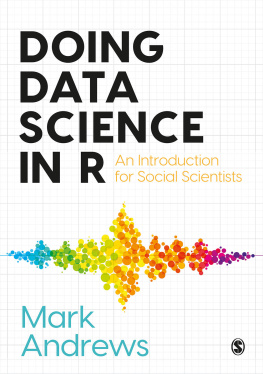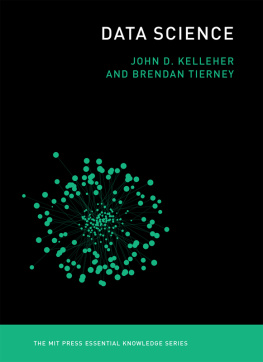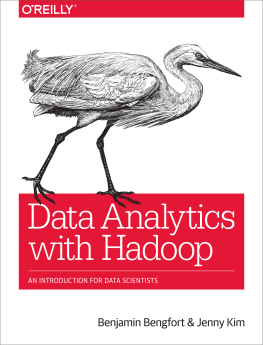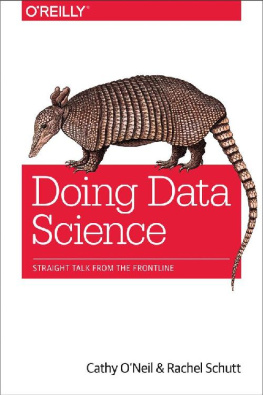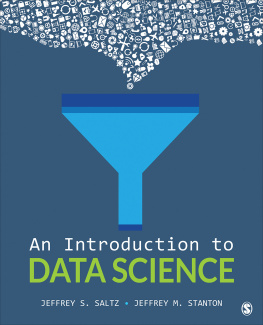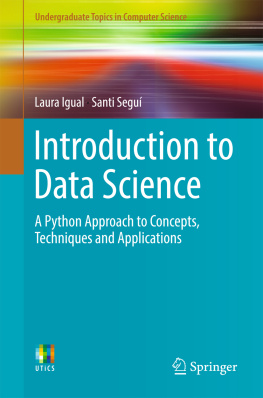Cecilia Aragon - Human-Centered Data Science: An Introduction : An Introduction
Here you can read online Cecilia Aragon - Human-Centered Data Science: An Introduction : An Introduction full text of the book (entire story) in english for free. Download pdf and epub, get meaning, cover and reviews about this ebook. year: 2022, publisher: MIT Press, genre: Politics. Description of the work, (preface) as well as reviews are available. Best literature library LitArk.com created for fans of good reading and offers a wide selection of genres:
Romance novel
Science fiction
Adventure
Detective
Science
History
Home and family
Prose
Art
Politics
Computer
Non-fiction
Religion
Business
Children
Humor
Choose a favorite category and find really read worthwhile books. Enjoy immersion in the world of imagination, feel the emotions of the characters or learn something new for yourself, make an fascinating discovery.

- Book:Human-Centered Data Science: An Introduction : An Introduction
- Author:
- Publisher:MIT Press
- Genre:
- Year:2022
- Rating:5 / 5
- Favourites:Add to favourites
- Your mark:
- 100
- 1
- 2
- 3
- 4
- 5
Human-Centered Data Science: An Introduction : An Introduction: summary, description and annotation
We offer to read an annotation, description, summary or preface (depends on what the author of the book "Human-Centered Data Science: An Introduction : An Introduction" wrote himself). If you haven't found the necessary information about the book — write in the comments, we will try to find it.
Cecilia Aragon: author's other books
Who wrote Human-Centered Data Science: An Introduction : An Introduction? Find out the surname, the name of the author of the book and a list of all author's works by series.
Human-Centered Data Science: An Introduction : An Introduction — read online for free the complete book (whole text) full work
Below is the text of the book, divided by pages. System saving the place of the last page read, allows you to conveniently read the book "Human-Centered Data Science: An Introduction : An Introduction" online for free, without having to search again every time where you left off. Put a bookmark, and you can go to the page where you finished reading at any time.
Font size:
Interval:
Bookmark:
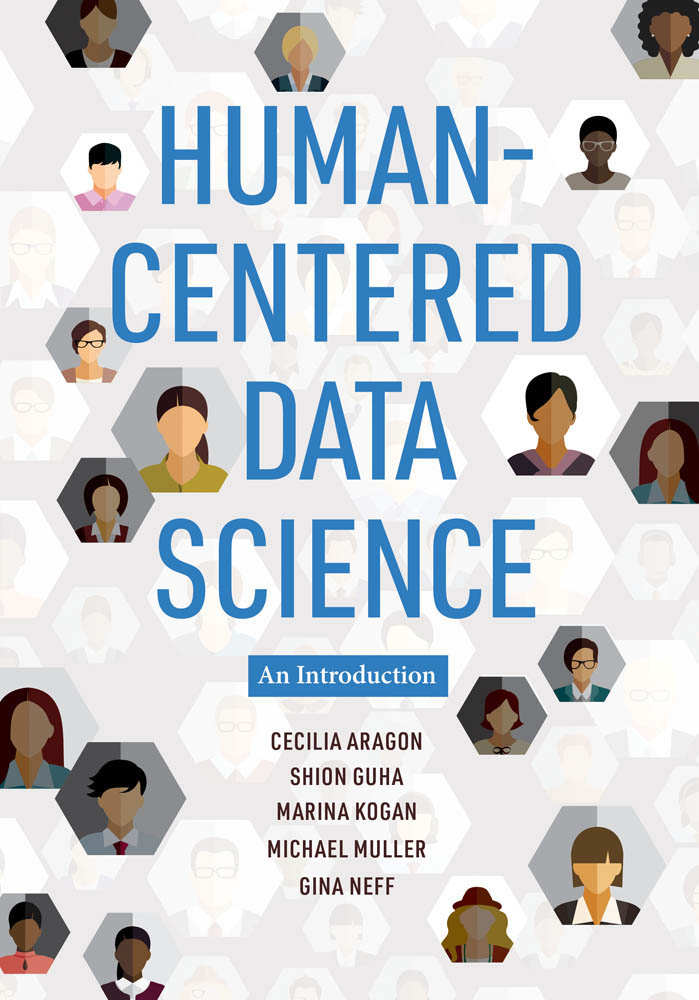
An Introduction
Cecilia Aragon, Shion Guha, Marina Kogan, Michael Muller, and Gina Neff
The MIT Press
Cambridge, Massachusetts
London, England
2022 Cecilia Aragon, Shion Guha, Marina Kogan, Michael Muller, and Gina Neff
All rights reserved. No part of this book may be reproduced in any form by any electronic or mechanical means (including photocopying, recording, or information storage and retrieval) without permission in writing from the publisher.
The MIT Press would like to thank the anonymous peer reviewers who provided comments on drafts of this book. The generous work of academic experts is essential for establishing the authority and quality of our publications. We acknowledge with gratitude the contributions of these otherwise uncredited readers.
Library of Congress Cataloging-in-Publication Data
Names: Aragon, Cecilia Rodriguez, author. | Guha, Shion, author. | Kogan, Marina, author. | Muller, Michael (Data scientist), author. | Neff, Gina, 1971 author.
Title: Human-centered data science : an introduction / Cecilia Aragon, Shion Guha, Marina Kogan, Michael Muller, and Gina Neff.
Description: Cambridge, Massachusetts : The MIT Press, [2022] | Includes bibliographical references and index.
Identifiers: LCCN 2021019747 | ISBN 9780262543217 (paperback)
Subjects: LCSH: Big dataMoral and ethical aspects. | Social indicatorsData processing. | Quantitative researchMoral and ethical aspects. | Information science.
Classification: LCC QA76.9.B45 A73 2022 | DDC 005.7dc23
LC record available at https://lccn.loc.gov/2021019747
d_r0
To our students, both past and future, who work to make data science better
List of Figures
The data science cycle.
Confusion matrix.
Anscombes quartet. Four simple datasets with identical descriptive statistics but completely different characteristics (Anscombe 1973).
Sample Jupyter notebook with code and comments.
K-anonymity example from patient and zip-code data.
K-means clustering of Fishers Iris dataset.
Principal component analysis of Fishers Iris dataset.
LDA topic modeling output example.
Artificial neural network for vacation recommendations.
Linear regression on cars dataset (speed versus distance).
Logistic regression on a diabetes dataset.
Decision tree example from Fishers Iris dataset.
Support vector machine example on random data.
Bayesian network from a smoking cessation dataset.
Hierarchical Bayesian model example.
Scatterplot of cars dataset: weight versus mileage.
Bubble plot of cars dataset: weight versus mileage by horsepower.
UK Policy Labs model for combining big data and thick data (Siodmok 2020).
Participatory analysis of one persons experience with the data science cycle. The faces are decorative stickers that indicate steps in the cycle where collaboration took place. In addition to the stickers, the informant provides rich contextual information about why the project was done, who was on the data science team, and how their work practices contributed to the outcomes of their project.
Combining small-scale qualitative analyses with large-scale quantitative analyses. The analyst can extract a useful concept from each type of analysis and use that concept to reshape or tune the next, alternating type of analysis.
Patterns of collaboration among members of data science teams. Teams in other studies include additional roles, such as statistician and data scientist. See Muller et al. (2019) for a more extended list.
Patterns of collaborations across the data science cycle.
Tools used during different phases of the data science cycle.
Martini glass metaphor for data journalism.
The authors wish to thank the many people who contributed to this book, beginning with our patient and highly responsive editor at the MIT Press, Gita Devi Manaktala.
Significant thanks are due to the attendees and co-organizers of the Computer-Supported Cooperative Work and Social Computing (CSCW) 2016 workshop on Human-Centered Data Science, where it first became clear we needed to document this new field. Next, we thank participants in the CHI 2019 workshop on Human-Centered Study of Data Science Work Practices; the GROUP 2020 workshop on Mapping out Human-Centered Data Science: Methods, Approaches, and Best Practices; and the CSCW 2020 workshop on Interrogating Data Science.
We particularly wish to thank Faith Bosworth from Book Sprints for keeping us on track with a gentle but relentless hand throughout our writing workshop in Seattle in February 2020. We also owe Jane Skau and Adeline Swires a great deal of gratitude for providing excellent logistical support during our writing workshop, keeping us well supplied and fed during a period of intense collaborative work.
We wish to thank the Gordon and Betty Moore and Alfred P. Sloan Foundations for their generous support of the eScience Institute at the University of Washington and for funding to help support this work. Support of a British Academy Mid-Career Fellowship is gratefully acknowledged.
We are grateful to Morgan Vigil-Hayes for her recommendations about Indigenous topics, to Theresa Jean Tanenbaum for consultations on gender identity, and to Andrea Simenstad for a careful reading of the final draft.
We thank the anonymous MIT Press reviewers whose detailed and thoughtful comments greatly improved the book and a brilliant team of editors and copyeditors who helped us get it in shape for publication.
Finally, we thank the authors of the case studies for sharing their excellent practical examples showcasing the wide variety in the field of human-centered data science.
On October 9, 2017, Frank Lantz released a simple game based on the following premise: What if we created an AI (artificial intelligence) with an apparently innocent goal: make as many paperclips as possible, as efficiently as possible?
It sounds nonthreatening, even boring. But the clicker game, Universal Paperclips, promptly went viral. And as this story illustrates, the unintended consequences of a relatively simple algorithm can lead to the destruction of the universe. The problem is that an algorithm will execute exactly what its designer told it to do. If the designer forgot to program in bounds or stopping conditions (or common sense, ethics, or human values), the program will continue beyond the designers original intent for an unbounded amount of time.
In this example, the lack of a stopping condition meant turning all the matter in the universe into 3 1055 paperclips.
At a moment of great optimism and enthusiasm for data science, coupled with a rising awareness of systemic societal injustices, this story resonates. Fields as diverse as computer science, artificial intelligence, social science, and even science fiction have been wrestling for decades with similar types of questions about ethics and boundaries and designers responsibilities. Now we have access to much more data than humans can reliably make sense of, and these kinds of doomsday scenarios, along with algorithmic biases on smaller scales, have become greater risks.
It is common to hear people saying that we can guard against bias or racism in, say, mortgage lending with software that makes a less biased evaluation of applicants. That way, you remove human error and human prejudice from the equation, right? Those biased bankers or racist lenders will no longer be able to discriminate against people because of the color of their skin or what they were wearing on the day they walked into the office to apply.
Next pageFont size:
Interval:
Bookmark:
Similar books «Human-Centered Data Science: An Introduction : An Introduction»
Look at similar books to Human-Centered Data Science: An Introduction : An Introduction. We have selected literature similar in name and meaning in the hope of providing readers with more options to find new, interesting, not yet read works.
Discussion, reviews of the book Human-Centered Data Science: An Introduction : An Introduction and just readers' own opinions. Leave your comments, write what you think about the work, its meaning or the main characters. Specify what exactly you liked and what you didn't like, and why you think so.


